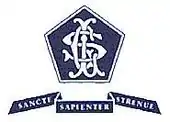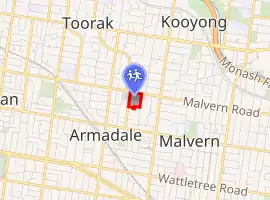Lauriston Girls' School
Lauriston Girls' School is an independent, non-denominational, day school for girls, located in Armadale, an inner south-eastern suburb of Melbourne, Victoria, Australia.
| Lauriston Girls' School | |
|---|---|
 | |
| Location | |

| |
| , Australia | |
| Coordinates | 37°51′6″S 145°1′32″E |
| Information | |
| Type | Independent, single-sex, day school |
| Motto | Latin: Sancte Sapienter Strenue (Holiness, Wisdom, Strength) |
| Denomination | Non-denominational |
| Established | 1901[1] |
| Chairman | Elspeth Arnold |
| Principal | Susan Just |
| Staff | ~145[2] |
| Enrolment | ~1,040 (P-12)[3] |
| Colour(s) | Navy blue and white |
| Slogan | A school for life |
| Website | lauriston |
The school follows the motto; Sancte, Sapienter, Strenue. This motto is Latin for Holiness, Wisdom, Strength
Established in 1901, Lauriston has a non-selective enrolment policy and is co-educational for three-year-old and four-year-old Kindergarten, and girls-only from Prep through to Year 12. The school currently caters for approximately 1040 students and offers the Victorian Certificate of Education (VCE) and is also one of the few Victorian schools that offer the International Baccalaureate (IB) for the Year 11/12 students.
Lauriston is affiliated with the Association of Heads of Independent Schools of Australia (AHISA),[4] the Junior School Heads Association of Australia (JSHAA),[5] the Alliance of Girls' Schools Australasia (AGSA),[6] the Association of Independent Schools of Victoria (AISV),[1] and is a founding member of Girls Sport Victoria (GSV).[7]
Campus
Armadale
Lauriston's main campus is located in Armadale, seven kilometres from the Melbourne CBD.[8] The Armadale campus is architecturally interesting as it comprises not only classic Victorian buildings (such as Montrose in the primary school area), but also newer buildings such as a science and technology centre constructed from energy-efficient, environmentally-friendly materials. Kindergarten through to Year 12, excluding year 9, are educated at the Armadale campus.
Howqua
The school has a rural campus for its year 9 students, known as 'Howqua', near the town of Mansfield in the Victorian high country.[8] Attendance is compulsory for all year 9 students, with the girls spending the whole school year on the campus as full-time boarders. It is similar to Timbertop, run by Geelong Grammar School, but students generally take part in a wider range of outdoor activities. Students at Howqua participate in activities such as downhill and cross-country skiing, horse riding, solo camping, hiking, rafting, rock climbing and other outdoor recreational activities, culminating the year with a 6-day hike through Victoria's mountainous regions. Students also participate in a community service rotation during the winter term, which involves activities such as building tracks, planting trees, gardening, visiting residential homes, acting as assistant teachers in rural schools, and running their own radio station.
There are 10 houses, each able to hold 12 girls although generally holding 10. These houses are Hollyer, Gillespie, Thompson, O'Brien, Fitz-Gibbon, Wirringga, Arthur-Robinson, Cramond, Mirrabooka and Kirkpatrick. Each house has beds, a bathroom, a kitchenette, dining/main area, wardrobe spaces, hike room, drying room and two balconies. The campus also offers a dining hall, a "dungeon" which doubles as a fire shelter, classrooms, Resource centre/library, music rooms, health centre, art centre, dance studio and staff houses. The campus offers running tracks such as the ring road, rainbow track, weir track (a 4 km run), lone pine (originally named Peg Slam J- using the letters of the girls' names who built the track as part of their community service) and more. At the end of each term, a running challenge of 9.4 km is to be run in 1hr, called the Howqua River Road Challenge.
It began in 1993 and in 1997 it became compulsory for students to attend the Howqua campus for the duration of a full school year. Originally students stayed at Howqua for 1 semester only, now it is compulsory for them to stay the whole year.Girls return home once a term on exeats (3 to 5 days) and return home for term holidays, before departing for Howqua again.
The concept of Howqua is to help girls develop emotionally and physically independent of their family in a world without constant technology. Mobile phones and laptops are banned from use at Howqua and internet access is also not allowed. It also aims to forge strong relationships between girls and social skills are greatly developed. All-year-round Howqua girls are urged to push themselves to achieve their goals, strengthening their sense of self-determination. The year leads up to many major end-of-year challenges, including a 17.3 km run from Telephone Box Junction on Mt Stirling to the summit, continuing onwards up Bourke St to the summit of Mt Buller.
In the 2006/2007 summer holidays, bushfires greatly threatened the Howqua Campus. The campus was also very threatened by fires and evacuated for the first time in early 2009.
Curriculum
The Lauriston curriculum is managed within five learning areas, based on the developmental stages of children and adolescents.
- Kindergarten: 3 and 4 Year Old
- Junior School: Transition Prep to Year 6
- 7/8 Centre: Year 7 and 8
- Howqua: Year 9
- Senior College: Year 10, 11 and 12[9]
Upon graduation, Lauriston students typically achieve high Australian Tertiary Admission Rank (ATAR) and International Baccalaureate (IB) scores. In 2016, 7% of students received an ATAR of 99 or over, 36% achieved 95 or over, and 60% of students received ATAR scores of 90 or over. The school has consistently ranked highly across the state, with a median VCE study score in 2016 of 36.
Co-curriculum
Music
Lauriston's music program caters for students from Prep to year 12 and offers a number of choral and instrumental ensembles, including bands and orchestras. Annually, there are approximately twenty-five performance occasions, including the 'Annual School Concert', which is held at the Melbourne Recital Centre.
From Years 3 and 4, a compulsory string orchestra group is formed. Violin, viola, cello, and double bass is assigned to them.
Lauriston also stages one musical and one play each year, one for students in years 5 to 8 and another for years 10 to 12. Recent performances include Seussical, Charlie and the Chocolate Factory, and The Little Mermaid Jr.
Sport
Lauriston offers over 20 sports, which may be played at both competitive and recreational level. The school is an inaugural member of Girls Sport Victoria (GSV), an association of 24 girls schools throughout Melbourne. Through GSV, students in years 7 to 12 may compete at an inter-school level in athletics, basketball, cricket, cross country, diving, golf, hockey, indoor cricket, netball, soccer, softball, swimming, tennis, volleyball, and water polo.[10]
Lauriston has a successful history in rowing. They usually compete in IVs but have occasionally raced a VIII. At the 2010 Head of the Schoolgirls Regatta the Lauriston senior crews won the Div 1 schoolgirl IV, Div 2 schoolgirl IV and Div 3 schoolgirl IV. The first IV were national gold medallists in the Schoolgirl IV in 2010, 2011 and 2013 and won a bronze medal in 2015.
Notable alumnae
Alumnae of Lauriston Girls' School are known as 'Old Lauristonians', and may elect to join the school's alumni association, the 'Old Lauristonian Association' (OLA).[11] Some notable 'Old Lauristonians' include:
- Hildred Mary Butler – microbiologist[12]
- Margaret Carnegie AO – writer, art patron and collector[13]
- Coco-Jacintha Cherian – actress (Neighbours, Taj)[14]
- Deborah Conway – Singer[15]
- Esme Mary Sorrett (Molly) Fink – Rani of Pudukota (wife of Marthanda Bhairava Tondiman, rajah of the southern India principality of Pudukota)[16]
- Beattie Goad – Soccer player with Melbourne Victory and Melbourne City
- Chloe Hooper – Writer and novelist[15]
- Sybil Howy Irving MBE – Founder and controller of the Australian Women's Army Service[17]
- Felicity Kennett – Former presenter of Network Ten TV lifestyle program Healthy, Wealthy and Wise; Wife of former Victorian Premier Jeff Kennett[15]
- Poppy King – Businesswoman; Young Australian of the Year 1995 (also attended Wesley College, Melbourne)[18]
- Elizabeth Kilgour Kirkhope – Former headmistress of Lowther Hall Anglican Grammar School; Former owner and headmistress of Lauriston Girls' School (Dux & Head Prefect 1914)[19]
- Jo Lane – Artist
- Kit Willow Michelmore – Fashion designer[15]
- Livinia Nixon – Channel 9 presenter and the Ambassador and face for the City of Melbourne[15]
- Linda Phillips, OBE – composer, pianist and music critic
- Heli Simpson – Actress. The Saddle Club
- Sarina Singh – Writer, author, filmmaker
- Fiona Stewart – Founder NotGoodEnough.org and partner of Philip Nitschke[15]
- Kathleen Alice Syme – Journalist, company director and welfare worker[20]
- Jessie Vasey – Founder of the War Widows' Guild of Australia (also attended Methodist Ladies' College, Melbourne)[21]
See also
- List of schools in Victoria
- Victorian Certificate of Education
- International Baccalaureate
- C. Rasmussen, Lauriston: 100 years of Educating Girls, The Helicon Press, Sydney 1999
- 1940 Lauriston School hosted the world premiere of The Magic Basket
References
- "Lauriston Girls' School". Find a School. Association of Independent Schools of Victoria. 2007. Archived from the original on 6 July 2011. Retrieved 16 January 2008.
- Lauriston Girls' School: Lauriston Council Annual Report 2006 (accessed:04-09-2007)
- Butler, Jan (2007). "womenleading@global.edu" (PDF). The Alliance of Girls' Schools Annual Conference. Melbourne, Vic.: The Alliance of Girls' Schools (published 15 June 2007). p. 2. Archived from the original (PDF) on 30 August 2007. Retrieved 2 October 2007..
- "AHISA Schools". Victoria. Association of Heads of Independent Schools of Australia. January 2008. Archived from the original on 2 November 2007. Retrieved 16 January 2008.
- "JSHAA Victorian Directory of Members". Victoria Branch. Junior School Heads' Association of Australia. 2007. Archived from the original on 13 February 2008. Retrieved 16 January 2008.
- Butler, Jan (2006). "Member Schools". Members. The Alliance of Girls' Schools Australasia. Archived from the original on 19 July 2008. Retrieved 16 January 2008.
- Mawkes, Leonie (2005). "Member Schools". Profile. Girls Sport Victoria. Archived from the original on 7 October 2007. Retrieved 11 October 2007.
- Lauriston Girls' School: Campus Location Archived 29 August 2007 at the Wayback Machine (accessed:04-09-2007)
- Lauriston Girls' School: Our School Archived 29 August 2007 at the Wayback Machine (accessed:04-09-2007)
- Lauriston Girls' School: Sport Archived 29 August 2007 at the Wayback Machine (accessed:04-09-2007)
- Lauriston Girls' School: OLA – Old Lauristonians' Assoc. Archived 29 August 2007 at the Wayback Machine (accessed:04-09-2007)
- Australian Dictionary of Biography: Butler, Hildred Mary (1906–1975) (accessed:27-07-2007)
- "Great collector of art and teller of our tales". The Sydney Morning Herald. 9 August 2002. Retrieved 1 January 2021.
- es:Coco-Jacinta Cherian
- Crikey.com.au: Famous alumni on Latham's hit list Archived 26 September 2007 at the Wayback Machine (accessed:26-04-2006)
- Fink, Esme Mary Sorrett (Molly) (1894–1967) (accessed:27-07-2007)
- Australian Dictionary of Biography: Irving, Sybil Howy (1897–1973) (accessed:27-07-2007)
- de Silva, Janet (29 August 2005). "Girl power". Education News. Melbourne: The Age. Retrieved 27 July 2007.
- Australian Dictionary of Biography: Kirkhope, Elizabeth Kilgour (1896–1978) (accessed:27-07-2007)
- Australian Dictionary of Biography: Syme, Kathleen Alice (1896–1977) (accessed:27-07-2007)
- Australian Dictionary of Biography: Vasey, Jessie Mary (1897–1966) (accessed:27-07-2007)